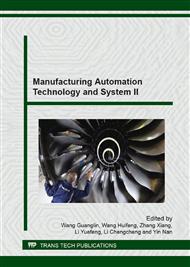p.51
p.57
p.63
p.69
p.75
p.82
p.88
p.94
p.101
Effect of Cutting Speed on Wear Property of TiAlN PVD Coated Tools in High-Speed Milling of AISI P20 Mold Steel
Abstract:
High speed cutting is an important means to improve the efficiency and the quality of machining mold steel, but the tool wear is one of the key factors restricting the increase of the cutting speed, leading to higher requirements for cutting tool materials. At present the researches of high-speed cutting of mold steel are mainly on the hardness mold steel, but less on P20 mold steel which hardness is 30-42HRC. This paper mainly studies the effect of cutting speed on wear property of TiAlN PVD coated tools when high-speed milling of P20 mold steels. The experiment was conducted using two different high cutting speeds under dry condition, 320m/min and 500m/min. Wear characterization of the rake and the flank surfaces as well as the collected chips were performed using scanning electron microscopy (SEM) and energy dispersive X-ray analysis (EDX). It was found that at high speeds, the dominant wear mechanisms were oxidation wear and diffusion wear, followed by adhesive wear and melt wear; as the cutting speed increased, the wear surface area of rake face will be closer to the main cutting edge.
Info:
Periodical:
Pages:
75-81
Citation:
Online since:
August 2014
Authors:
Keywords:
Price:
Сopyright:
© 2014 Trans Tech Publications Ltd. All Rights Reserved
Share:
Citation:


